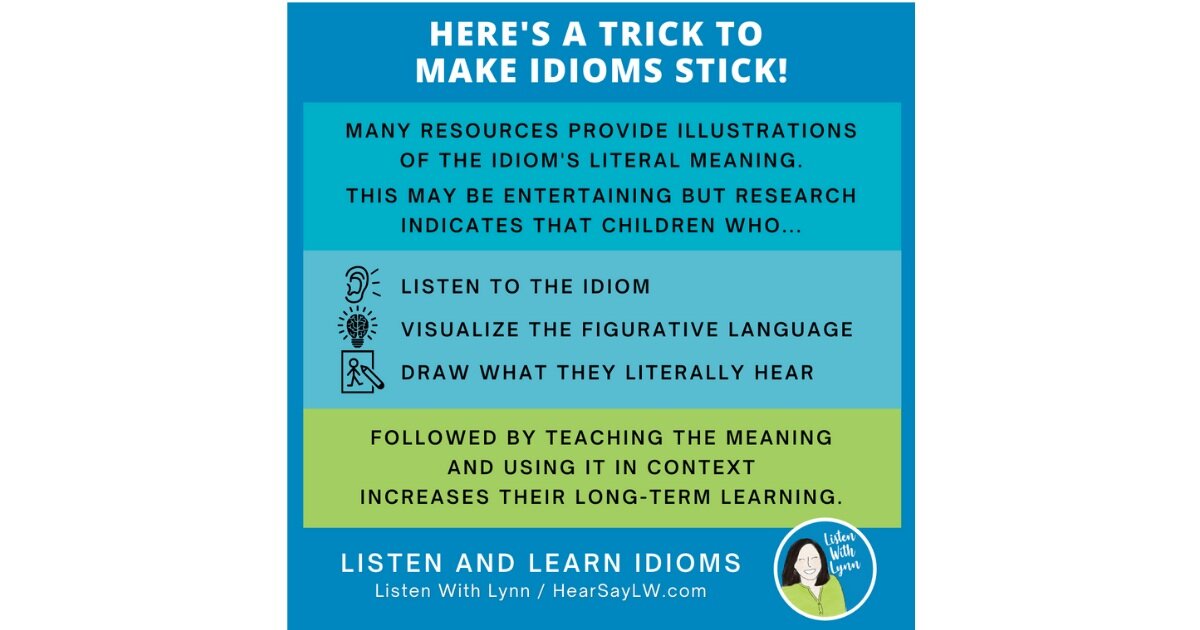Idioms are a type of figurative language that has meanings different from their actual words. They cannot be guessed based on the words individually. Idioms are sayings that provide colorful descriptions and are common in spoken language and literature such as, “She’s a cool as a cucumber.” which is an idiom that really means she’s calm and relaxed.
Children with typical hearing, learn idioms through incidental exposure without having to be taught. Whereas, children who are deaf and hard of hearing often require explicit and direct instruction with figurative language. Idioms are challenging for children that process information literally and have a concrete or limited vocabulary.
Here’s a trick!
Do you realize that many resources show photos or illustrations of the idiom’s literal meaning? While these are often funny and entertaining they may rob the child of using their critical thinking skills. So allow the children to first -
This is followed by teaching the meaning of the idiom and using it in context which can build long-term learning. This is the premise behind the Listen and Learn Idioms Series.
Idioms can be as much fun as a Barrel of Monkeys
Teaching idioms may seem intimidating at first. It doesn’t have to be complicated or difficult.
The I’m All Ears resources make teaching idioms a piece of cake. Children listen to a common idiom and draw a picture of what they literally hear. To a child, their drawings are a source of humor but are brain-building opportunities. This helps learners understand and use idioms spontaneously. They build vocabulary, expand high-level language skills of figurative language, word relationships, and nuances in word meanings.
Start simple - Easy as A B C
Lists of idioms even if they are easy or commonly heard can be overwhelming to a child and their parents. So, introduce idioms one by one.
1. Illustrate idioms together during therapy sessions or lessons at school until the child grasps the concept. Use the Listen & Learn With Idioms activity sheets with crayons, markers, or colored pencils.
2. The child can make a booklet or folder and then take the activity sheets home. Give the parents or caregivers suggestions for ways to use idioms naturally in their daily routines.
Listening and Spoken Language (LSL) TIPS
1. Idioms are abstract. For new vocabulary to stick, teach with real experiences.
2. Provide lots of exposure to the targeted idiom frequently and in multiple contexts.
3. Say the idiom and then WAIT to give the child time to process the idiom.
4. Use the child’s auditory feedback loop by asking what idiom they heard before repeating it.
5. Teach the idioms in complete sentences. This allows for learning how the idiom relates to other grammatical structures and places it as part of an auditory mental map.
6. Read aloud daily. Books introduce unusual vocabulary like idioms that may not come up every day but which are important for the child to have in their repertoire.
Ideas to get started
Idiom - Dirty Look
This is what I heard: Draw two eyes then rub a little dirt on the page over the eyes.
This is what it really means. Say What? DRAW a frowning face in the space or WRITE,
“A look that shows the person is angry or annoyed.
Use in context. - I was laughing too loud at the movies so a man gave me a dirty look.
Idiom - A Green Thumb
This is what I heard: Draw a green thumb or dip the child’s thumb in green paint to stamp on the paper.
This is what it really means. Say What? DRAW leafy green plants or in the space or WRITE, “A person who is good at growing plants.”
Use in context. - Grandma is an award-winning gardener who is well known for her green thumb
Idiom - Ants in Your Pants
This is what I heard: Draw a pair of pants with crawling ants.
This is what it really means. Say What? DRAW a person wiggling in the space or WRITE, “You can’t sit still. Wiggling and restless.”
Use in context. - During the long airplane trip, I had ants in my pants.
Here are a Boat Load of read-aloud books about idioms
Birds of a Feather: A Book of Idioms and Silly Pictures by Vanita Oelschlager
Butterflies in My Stomach and Other School Hazards by Serge Bloch
In a Pickle: And Other Funny Idioms by Marvin Terban and Giulio Maestro
Mad as a Wet Hen!: And Other Funny Idioms by Marvin Terban and Giulio Maestro
Monkey Business: Fun With Idioms (Milet Wordwise) by Laura Hambleton
Parts by Tedd Arnold
Reach for the Stars: and Other Advice for Life’s Journey by Serge Bloch
Super Silly Sayings That Are Over Your Head: A Children's Illustrated Book of Idioms by Catherine S. Snodgrass
You Are What You Eat: and Other Mealtime Hazards by Serge Bloch



